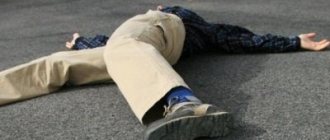Description of the disease
Anorexia in children is less common compared to adult patients - 4-6% versus 8-15%.
According to statistics, the problem does not arise earlier than 11-12 years. Mostly girls suffer. However, over the past few years, the number of boys experiencing anorexia in adolescence has been increasing (from 0.29% to 1.14%). Childhood anorexia is a disease that today raises more questions than it answers. Pathology is difficult to identify in the early stages of development, since the child himself does not immediately understand that he is deliberately refusing to eat. Scientists believe that official data does not fully reveal the full picture of the spread of the problem, since statistics only take into account clinically significant (complicated) cases when a child requires intensive care.
Anorexia nervosa is a disease characterized by a combination of a psychological/psychiatric disorder with somatic disorders. Against the background of changes in the child’s behavior due to a lack of nutrients in the body, a number of negative and dangerous changes occur. They affect the functioning of almost all organs and systems. Depending on the loss of body weight, the following degrees of severity of the disease are distinguished:
- I – body weight deficiency ranges from 10 to 19%;
- II – 20-29%
- III – more than 30%.
The danger of anorexia in children lies in the inadequate functioning of internal organs and systems against the background of malnutrition.
This threatens the development of such consequences as general exhaustion, impaired development of the nervous system, diseases of the musculoskeletal system, infertility, gastrointestinal dysfunction and others. When identifying signs of childhood anorexia nervosa, it is recommended not to waste time trying in vain to fix something on your own.
Only qualified assistance from several specialists at the same time will allow you to achieve a good therapeutic result. And the sooner treatment is started, the faster the recovery will come.
Clinical picture
Since the true form of pathology is only a consequence of the underlying disease, it makes sense to talk about the symptoms of anorexia nervosa. The clinical picture of the disease is very diverse, especially since certain symptoms of anorexia may occur at one stage of the disease and be absent at another.
Eating disorder
First of all, the signs of anorexia are caused by an eating disorder:
- an obsessive desire, up to the development of mania, to lose weight, although objectively there is a deficiency of body weight or compliance with its norm;
- fatphobia (obsessive fear of being overweight/fat);
- thoughts and ideas related to food are obsessive and disturbing: counting calories (even in toothpaste), narrowing interests, fixating all thoughts on the question “how to lose weight”;
- regular refusal to eat, explained either by lack of appetite or a recent snack, limiting the amount of food served;
- ritualism in eating: careful serving, but in small portions, cutting very small pieces, chewing for a long time;
- refusal to attend events where food is expected, the occurrence of psychological discomfort after eating.
Mental changes
There are also mental state disorders, as well as other characteristic signs of behavior:
- patients strive to perform heavy physical exercises, if the planned load is not achieved, they experience irritation;
- The clothes of such people are spacious, baggy, hiding their imaginary fatness;
- inertia of thinking, rigid and fanatical beliefs, and defending them reaches the point of aggressiveness;
- avoidance of society, desire for solitude, but easily get along with other victims of imaginary excess weight;
- the psyche is in a depressed state, up to apathy and the development of depression;
- inability to concentrate;
- decreased performance;
- problems sleeping, insomnia;
- focusing on one’s own problems associated with “excess weight”;
- body dysmorphomania – dissatisfaction with one’s weight, appearance, behavior (weakness and desire for food), success in losing weight;
- emotional lability;
- feeling of loss of control over oneself, futility of efforts;
- inability to lead an active life;
- constant weight loss is not regarded as a disease, a categorical refusal of treatment and food intake.
Physiological manifestations
In addition to eating disorders and general behavior, mental state disorders, there are physiological symptoms of anorexia in girls:
- significant deficit (30% or more) of weight (compared to the age norm);
- weakness, lethargy, fatigue, constant fatigue;
- low blood pressure - as a result of weight loss, weak vascular tone;
- low temperature, as a result of which patients are constantly freezing;
- digestive tract disorders (gastroenterocolitis, flatulence, constipation);
- dizziness, frequent fainting (hypotension);
- cardiac dysfunction (bradycardia, arrhythmia, etc.);
- dry flaky skin, dull brittle hair, layered nails (signs of vitamin deficiency);
- cold extremities, the skin on them with a marble tint (circulatory failure);
- swelling of the arms and legs;
- diffuse alopecia (baldness);
- lanugo – significant growth of vellus hair on the arms, legs, and torso;
- unpleasant odor from the mouth;
- rapid tooth decay;
- prolapse of internal organs (genitals, kidneys, liver);
- “bruise syndrome” - a tendency to hemorrhage;
- disorders of the menstrual cycle, up to the complete cessation of menstruation and the development of infertility;
- amyotrophy;
- dystrophy of internal organs with the occurrence of multiple organ failure;
- decreased or absent libido;
- fragility of bones, tendency to fractures (osteoporosis).
Stages of the disease
In its development, the disease goes through several stages:
Primary or initial
The duration of this stage is 2 - 4 years and is characterized by dysmorphomania syndrome - dissatisfaction with one's appearance, delusional or overvalued ideas arising on this occasion to improve one's body, as well as depression. In teenagers, this stage manifests itself in the form of imaginary shortcomings: a better figure or round cheeks, too thick thighs or a stomach. Sometimes a painful conviction of one’s fatness is combined with pathological ideas about other shortcomings (fictitious or overestimated) of appearance (protruding ears, thick lips or nose). The dysmorphomanic stage is formed on the basis of a discrepancy between the patient and his “ideal” - a famous artist, model, close person. Any careless remarks from people close to you (parents, friends, teachers) triggers the mechanism of striving to “correct” your own shortcomings.
Anorectic
This stage begins with extreme activity in relation to the correction of their deficiencies, patients lose from 20 to 50% of their initial weight, they develop secondary somatoendocrine disorders, oligomenorrhea appears (in girls) or menstruation stops completely. Getting rid of “excess” weight is achieved in all possible ways and is hidden at first. First, patients actively engage in sports, increase physical activity, which is combined with limiting the amount of food they eat. When reducing food consumption, at the first stage carbohydrate and protein foods are excluded, then the diet becomes more severe, which leads to the consumption of only dairy and plant foods.
Patients develop special physical exercises for even greater weight loss, reduce sleep, and tighten their waist (“so food is absorbed more slowly”). In the first days of food restriction, patients may not experience a feeling of hunger, but more often it is present, forcing them to refuse food altogether and find new ways to lose weight (large doses of laxatives, enemas).
A common way to lose weight in patients is artificially induced vomiting. At first, vomiting occurs reflexively when the patient, unable to resist, eats a large amount of food at once (full stomach - vomiting). Then patients begin to induce vomiting on their own after eating, followed by washing the stomach to clean water, drinking up to 2 - 3 liters of water.
Another passive method of “losing” excess weight is taking medications (appetite suppressants and psychostimulants). Also, to correct weight, patients begin to smoke a lot, drink large quantities of black coffee, and take diuretics.
However, significant weight loss does not lead to physical weakness (yet); patients are mobile, active and productive. But still the body experiences physical suffering. Attacks of suffocation, palpitations, dizziness, and increased sweating appear, which occur a couple of hours after eating.
Cachectic
At this stage, somatoendocrine disorders come to the fore. Once persistent amenorrhea occurs, weight loss accelerates significantly. Such people have absolutely no subcutaneous fat layer, hair and teeth begin to fall out, and the skin peels off, myocardial dystrophy progresses. The heartbeat slows down, blood pressure decreases, the fingertips and nose turn blue, and the temperature drops. Blood sugar and hemoglobin levels are low. Patients are adynamic, spend more and more time in bed, and are indifferent to their surroundings.
Despite the threatening exhaustion, patients still refuse to eat and claim that they are overweight (mental disorder - impaired perception of their body). Persistent constipation occurs, blood pressure remains low and continues to decrease, muscle cramps and polyneuritis appear. In 20% of cases, patients with the cachectic stage die (multiple organ failure due to irreversible degenerative changes in internal organs).
Symptoms in children
In infants (up to one year), the signs of the disease are difficult to miss, since children do not hide their aversion to food that they do not want to eat. First, displeasure with the eating process appears, the child begins to be capricious and cry. Then comes the stage of regurgitation, when the baby unexpectedly burps while eating, although there are no signs of diseases of the digestive tract. Then the child begins to actively refuse food, does not take the breast, turns away, older children throw food and cutlery off the table, spit out food, and purse their lips. Subsequently, the baby refuses normal “adult” food (meat, vegetables, cereals), and wants something unusual (for example, lemons). While eating, children fill their mouths with food, but do not chew or swallow it.
In preschoolers, signs of anorexia are more difficult to identify; only in the later stages do symptoms of malnutrition appear (dizziness, itchy skin, constipation). It turns out that preschool children have long learned to artificially induce vomiting (at home, in kindergarten). A suspicious sign for parents is the child’s refusal of sweets. In preschool age, the cause of the disease can be psychological trauma (for example, parental divorce).
Symptoms of anorexia nervosa in children
The main symptom of childhood anorexia is excessive thinness of the child. It is not always easy to identify the disease in the early stages. Especially if the child does not undergo regular medical examinations, during which anthropometric measurements are taken. Most patients come to the attention of specialists already in advanced cases when serious drug treatment is required. In addition to lack of weight, anorexia can manifest itself with the following symptoms:
- loss of appetite and reluctance to eat;
- general weakness;
- sleep rhythm disturbance;
- pale skin as a result of anemia;
- irritability;
- Bulimia attacks – excessive desire to eat;
- deterioration of the condition of hair, nails, skin;
- an increase in the number of episodes of respiratory infections;
- poor healing of even minor injuries.
In addition to the above signs, the clinical picture may be accompanied by symptoms of dysfunction of internal organs. Most often, children complain of rapid heartbeat, shortness of breath, swelling in the lower extremities, and nausea.
Types of anorexia
There are several types of childhood anorexia. The first is somatogenic. This problem is associated with the development of any diseases in the body. These could be infections, problems with the digestive tract, or oral diseases. Respiratory and circulatory disorders also lead to the development of anorexia. Other causes include chronic intoxication, allergies and worms. Therefore, if a child suddenly stops eating, then he urgently needs to be examined to identify the problem. All signs and symptoms of anorexia should disappear when the underlying disease is completely eliminated.
The second type of problem is neurotic. The reasons in this case are stress, improper sleep patterns and the day in general. However, a diagnosis can only be made after a thorough examination.
Causes of anorexia nervosa in children
The cause of childhood anorexia nervosa is considered to be adolescent dissatisfaction with their body.
Due to the constant influence of the media, the cultivation of certain ideals of beauty, and the demonstration of the success of individual representatives of show business, stereotypes are formed among teenagers. They evaluate themselves and try to be like their idols. As a result of such comparisons, dissatisfaction with one's own body arises. One of the options for solving the problem in the eyes of a teenager is the deliberate refusal of proper nutrition. Psychologists and psychiatrists have found in research that most patients with anorexia nervosa are hypersocial. This means that it is very important for them:
- to be the center of attention;
- receive positive feedback about your activities and appearance;
- achieve success in daily endeavors.
60-65% of teenagers suffering from this disease are class leaders, clubs or other meetings.
Many patients have an “excellent student complex.” Therefore, if they do not meet the criteria of their ideal, such teenagers are prone to radical measures to achieve their goal. One of them is to give up food to achieve noticeable weight loss. Psychologists also point out possible problems in the family when parents are too demanding of the child and constantly set other children or even adults as examples.
Expert opinion
As a psychologist, I must say that anorexia nervosa is a very serious problem that is gaining more and more momentum in modern society. Today there is a growing number of boys who want to be defenseless, gentle and also try to live up to their “ideals” by refusing food. The problem is that in the early stages of the disease it is very difficult to distinguish it from ordinary teenage disagreements with adults. This causes the progression of anorexia and serious changes in the internal organs. Unfortunately, in most cases, patients come to the appointment with already advanced forms of anorexia. Therefore, parents should devote more time to work and talk with their children. And if you identify any problems or suspicious complaints, you should not think that they will go away on their own. It is important to seek help in time before irreversible changes develop in organs and systems.
Diagnosis of anorexia nervosa in children
Diagnosis of anorexia involves a comprehensive analysis of the child’s condition, taking into account a number of factors.
The doctor conducting the appointment communicates in detail both with the patient himself and with his parents. When collecting anamnesis, special attention is paid to the following points:
- duration of existing changes in eating disorders;
- dynamics of growth, body weight (from the onset of the disease to the present);
- changes in the menstrual cycle in girls;
- the use of physical or medicinal methods for weight loss - provoking the gag reflex, taking laxatives, etc.;
- the presence of concomitant pathology.
After this, the patient is weighed and the body mass index (BMI) is calculated. The doctor evaluates the presence of digestive disorders. To fully assess body function, the patient undergoes a series of laboratory tests:
- general and biochemical blood test;
- general urine analysis;
- blood test for glucose;
- analysis for infectious group (HIV, syphilis, hepatitis B, C).
If there are abnormalities in the functioning of the gastrointestinal tract or cardiovascular system, electrocardiography (ECG) and fibroesophagogastroduodenoscopy (FEGDS) are additionally performed.
The patient is also advised by a psychiatrist, psychologist, and nutritionist. Based on the information received, a diagnosis of anorexia nervosa in children is established, the most likely cause is identified, and a comprehensive treatment program is drawn up.
Treatment
Treatment of children for anorexia involves working in two directions: restoring the gastrointestinal tract with subsequent weight gain and instilling a correct and healthy attitude towards food.
In the first case, classical methods of combating the disease are used. This includes eating five to six meals a day and maintaining a sleep schedule. The use of medications to relieve vomiting, diarrhea and constipation is also necessary.
At the second stage, doctors adhere to the following sequence: first - psychotherapy, then treat psychological abnormalities.
As a result, the patient returns to normal mode and is already able to control his emotions.
Main components of treatment:
- Cognitive behavioral therapy. It involves working with a psychotherapist, which lasts at least four months. Includes correction of unhealthy ideas, training in controlling pathological emotions. The doctor helps the patient develop adequate self-esteem, love for himself and his body. The teenager is encouraged to independently choose his own basic diet, which should include those foods that he excluded previously. The child starts a personal diary, where he writes down his thoughts and experiences, trying to transform them in a positive way.
- Family psychotherapy. The clinic holds special sessions where family problems that provoke the development of anorexia in a child are discussed. Parents should be explained what not to say or do in relation to a teenager, so as not to hurt his feelings and not provoke a relapse. Mother and father are obliged to contribute as much as possible to maintaining a positive atmosphere within the family in order to obtain good treatment results.
- Pharmacotherapy. Doctors additionally prescribe medication that will increase the effectiveness of psychotherapy and self-control of the child. As a rule, specialists prescribe antidepressants and appetite stimulants.
Treatment of anorexia nervosa in children
Anorexia in children is a serious clinical condition that requires a step-by-step approach to treating the patient. Therapy is carried out through diet, medication and psychotherapy. Separately, none of these methods produces the desired result. The entire process of conservative treatment of patients with anorexia can be divided into three large stages:
- Non-specific. This is the initial phase of treatment. It consists in correcting the vital functions of the body. Doctors use medications to normalize the water-salt balance and the concentration of electrolytes in the blood. Normal food tolerance gradually resumes (the body gets used to it and “learns” to accept and assimilate correctly). The main goal of this stage is to resume the functioning of all organs and systems. The duration of this period ranges from 7 to 14 days.
- Specific. At this stage, correction of body weight deficiency occurs. When the body is ready to take food, nutritionists develop an individual menu for each patient. In addition, a psychotherapist works with the child every day to correct the psycho-emotional reasons for refusing food and to find ways to solve the problem. The goal of this phase is to restore the patient to normal body weight and eliminate the cause of anorexia. The duration of the stage is up to 1 month.
- Rehabilitation. At this stage, the child is already at home. He returns to the normal rhythm of life. The psychotherapist can maintain contact with the patient, providing the necessary psychological assistance aimed at preventing relapse. The purpose of this phase is to consolidate the achieved result.
Treatment of anorexia in children is not only the work of doctors, but also the work of parents.
They become the child’s main assistants at the rehabilitation stage. It is important to remember that preventing the development of anorexia is much easier than treating it. Therefore, parents should always listen to their children, not ignore their problems and experiences, and seek qualified psychological help in a timely manner.
How to deal with anorexia
At the initial stage of development, adolescent pathologists undergo treatment on an outpatient basis; if 2 or 3 have developed, in inpatient settings. A combined approach to therapy is necessarily used, which consists of 3 areas:
- Psychotherapy. The doctor’s task is to correct the patient’s behavior, his relationships with relatives, to form a correct perception of the surrounding reality and his own weight without a stable connection to body weight, and to increase self-esteem. The child must receive moral support, and a system of rewards for positive results is allowed.
- Normalization of physical health. The main task is to normalize weight by adjusting nutrition. The presence of damage to internal organs is taken into account, the diet is based on a slow increase in calorie content of food
- Drug therapy. The patient is prescribed medications that help normalize his mental state, gain weight, restore intestinal microflora, and water-salt balance.
Drug treatment
Adolescents are more likely to be diagnosed with anorexia nervosa, which is difficult to treat. Not an effective and universal drug against pathology. Doctors take a holistic approach and prescribe general medications that are used to treat most health problems, such as heart rhythm problems or electrolysis abnormalities. The following medications are prescribed to suppress anorexia nervosa:
- Antidepressants. Patients with anorexia are susceptible to depression, which can be eliminated with the help of this group of medications. Only a doctor can prescribe them, because in medical practice there have been cases of side effects that aggravate the patient’s condition.
- Tranquilizers. Benzodiazepines are usually prescribed to help cope with anxiety. The drugs are addictive and are strictly prohibited for use by people with alcohol or drug addiction.
- Estrogen. Girls diagnosed with anorexia need to take this group of medications to avoid osteoporosis and cracks. Stopping menstruation can lead to a condition that is close to early menopause.
Psychological help
The development of anorexia often occurs against the background of a teenager’s inadequate perception of his own appearance, the world around him, and pressure from peers or parents. To overcome these problems, psychotherapeutic treatment methods are used:
- Cognitive analytic therapy. During sessions, situations that could lead to the formation of unhealthy behavior patterns are addressed. The doctor determines the necessary actions to promote the restoration of adequate forms of thinking and behavior.
- Cognitive behavioral therapy. It is based on the theory that awareness of the current situation influences the patient’s actions, and vice versa - actions influence thoughts. The patient’s unrealistic, inadequate thoughts about food influence the development of anorexia. The therapist tries to change the direction of the adolescent's thoughts in order to lead the patient to positive behavior.
- Interpersonal therapy. The therapy is based on theories about the powerful positive effects of relationships with other people on mental health. Low self-esteem, which leads to anorexia, limits the patient's ability to communicate with others. The doctor discusses negative relationships with the patient and what needs to be done to normalize them.
- Focused psychodynamic therapy. Unresolved conflicts in the past can affect a person in the present. At appointments, the teenager must determine the influence of past experiences on his condition.
- Family therapy. The work is carried out not only with the patient, but also with close relatives, who must understand the nature of the eating disorder.
- Hypnosis and Ericsson therapy. Hypnotherapy was first used to treat illness in the 19th century; modern research confirms the effectiveness of this type of treatment. Hypnosis helps to build self-confidence in a teenager, increase self-esteem and reduce depressive and stress disorders.
Healthy eating
An important stage in restoring health is gaining weight and replenishing missing nutrients. A diet for the treatment of anorexia is built on the following principles: the volume of food consumed is gradually increased so that the body again learns to process it fully, and the caloric content of food. The diet of adolescents during therapy must comply with the following rules:
- first you need fractional nutrition;
- In the early stages of treatment, preference should be given to pureed and liquid, crushed foods;
- gradually increase the calorie content of food; porridge is good for this;
- The diet must contain protein foods: dairy products, eggs, meat;
- the menu should include food products containing Omega-9 and Omega-3 fats;
- the body needs vitamins to restore itself; fruits and vegetables are good;
- consuming fermented milk products will help normalize the digestion process;
- protein and vitamin cocktails should be in the diet;
- Nutritional supplements will help speed up recovery: vitamin-mineral complexes, fish oil.
Questions
- Which doctor treats anorexia in children?
A psychiatrist, psychologist, nutritionist, and pediatrician should simultaneously identify and treat anorexia in children. - What body weight should a teenager have?
Normal body weight is calculated depending on the age of the child. All the necessary tables for comparison are publicly available. However, anorexia is not only about being too thin. This is a conscious action of the child aimed at refusing to eat. Thin children do not always suffer from anorexia. Formidable symptoms of the pathology are frequent regurgitation, general weakness and isolation of the child. - Is it possible to overcome anorexia with pills alone?
In 95% of cases, anorexia in children is a consequence of psychological discomfort. The problem relates to psychiatric diagnoses. Taking medications exclusively can only provide a short-term effect. Without the work of a psychotherapist aimed at identifying the underlying causes of this disorder, it will not be possible to achieve the desired therapeutic result. - Are there relapses of anorexia in children?
If the patient at the rehabilitation stage was unable to record the achieved result, but again succumbed to the influence of provoking factors, then there is a risk of relapse. Therefore, it is important for doctors, the child and parents to constantly work together for the patient’s recovery.
Sources
- Yager J, Devlin MJ, Halmi KA et al. Guideline Watch (August 2012): Practice Guideline for the Treatment of Patients With Eating Disorders, 3rd Edition. Am J Psychiatry. 2012; 163 (suppl.): 1–54.
- National Institute for Clinical Excellence: Eating Disorders: Core Interventions in the Treatment and Management of Anorexia Nervosa, Bulimia Nervosa and Related Eating Disorders: Clinical Guideline 9. London, National Institute for Clinical Excellence, 2004. https://www.nice.org .uk/pdf/cg009niceguidance.pdf
- Korkina M.V., Tsivilko M.A., Marilov V.V. Anorexia nervosa. M.: Medicine, 1986. 176 p.










